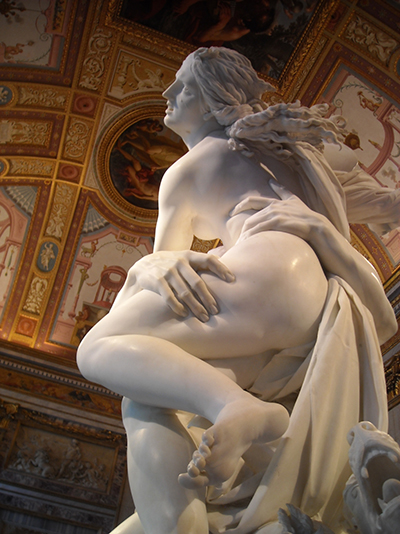The Rape of Proserpina by Gian Lorenzo Bernini is a large marble group comprising of Proserpina and Pluto, popular characters in Greek mythology.
This sculpture shows the powerful god of the underworld (Pluto) abducting Ceres’s daughter (Greek Demeter), the goddess in charge of fertility and harvest. Ceres's intercession with Jupiter permits her daughter to come back to earth for half a year and spend another half a year in Hades. As a result, she is welcomed with the earth every spring with a carpet of flowers.
Gian Lorenzo developed a twisting pose to remind the audience of Mannerism and combined this with an impression of vital energy. He created various moments and summed them up to form a single sculpture. Similar to some of his works, Gian Lorenzo managed to put tension and emotion in work to achieve a life-like action in the sculpture.
The ornate design, grandiose theatricality and attention to detail make this sculpture a unique art piece. This technique enables the sculpture to evoke heart-rending emotion among the audience who identify with the story portrayed. The Rape of Proserpina by Gian Lorenzo Bernini was a touch of class owing to the effort the artist put into it.
The style used in this sculpture is the Baroque style. Gian Lorenzo's career span during the Italian Baroque period. This form of art is tied to the political and religious context in the 16th and 17th century after the launch of Counter-Reformation by the Catholic church to attract followers.
Church leaders called for art pieces that would captivate the audiences, and this is one of them. The Baroque style valued theatrics, drama and engaging in naturalism. Gian Lorenzo managed to display some of these characteristics in his art pieces. In this sculpture, he depicted the most dramatic moment in the story to ensure the scene evokes emotions to the audience. The figures are displayed twisting and straining to opposing directions. In addition, he bestowed the figures with individualised features to bring out the naturalism.
In creating the Rape of Proserpina, Gian Lorenzo Bernini was not limited by the materials. He managed to create warmth, life and movement by carving the marble perfectly well. The excellent work done with the marble earned him earn a large following.
During his career, Gian Lorenzo had no shortage of commissioning as many prominent figures admired his work. The Rape of Proserpina by Gian Lorenzo Bernini was commissioned by Cardinal Scipione Borghese. The renowned patron of the arts in the early 17th century commissioned the sculpture because he wanted the artist to do a rendition of the story of the god Pluto and Roman goddess Proserpina. The characters are known as Persephone and Hades in Greek mythology respectively.
It looks odd for a Catholic cardinal to commission a story adapted from pagan mythology, but this was done to show that they were educated, refined and sophisticated to know about the Classic mythology. At the moment, The Rape of Proserpina by Gian Lorenzo Bernini is located at Galleria Borghese after the Italian state purchased it in 1908 before relocating it here. Gian Lorenzo exerted influence that he inspired other artists to create works on this theme. Some of these artists and their works include Max Kruse who created Persephone and Frederic Leighton who made the Return of Persephone.




